The best water purifiers and filters: clever devices for supplying safe drinking water on the trail and in camp
The best water purifiers filter out nasties and ensure you have access to potable water while hiking, biking and paddling
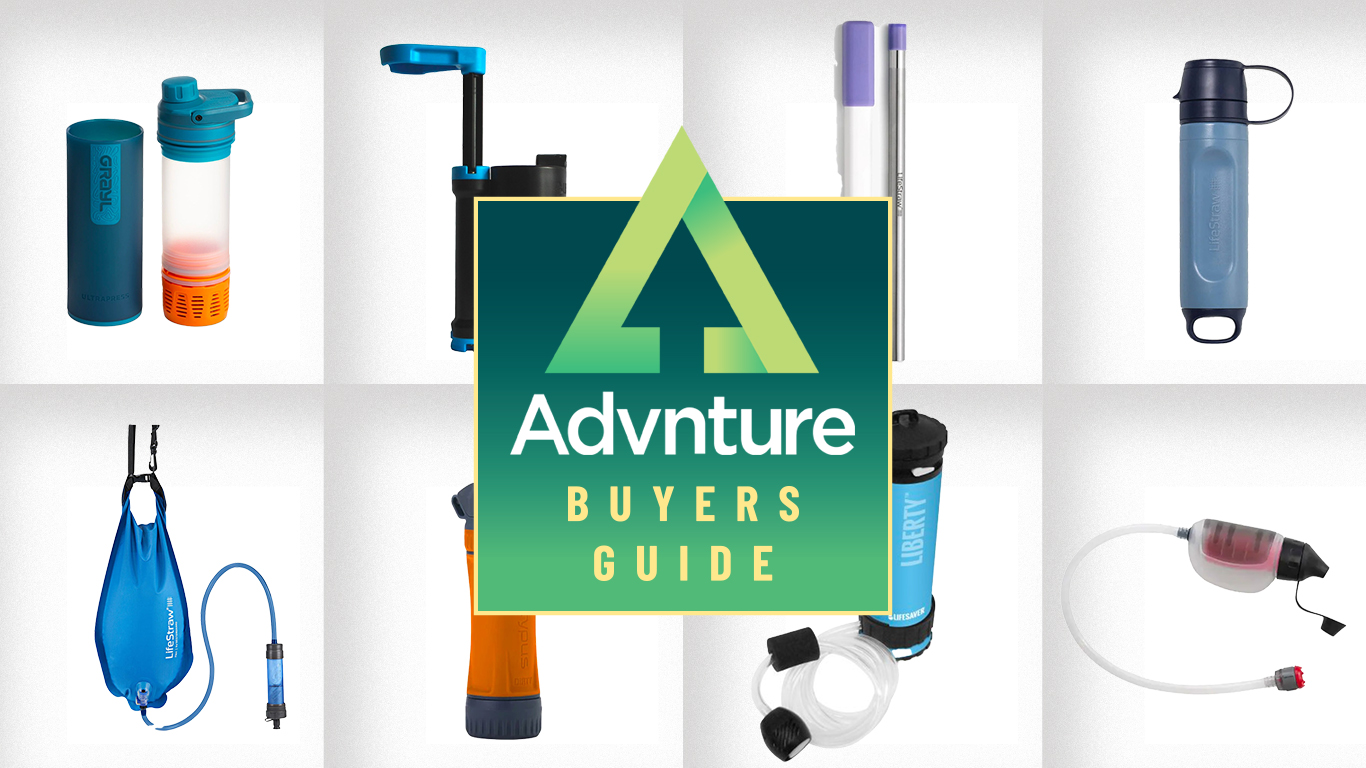
Water that's safe to drink is the single most important thing you need when you’re out and about adventuring, and that means finding the best water purifier or filter. While we are typically surrounded by H2O from one source or another, it can be contaminated, and it's not always possible to carry your hydration requirements on long adventures and multi-day trips – water is heavy and even carting a liter in the best hiking water bottles or hydration packs can impact your enjoyment.
Using a good camping stove you can boil water for several minutes in order to kill most waterborne bacterial and viral pathogens, plus pesky protozoa (tiny, single-cell creatures that can be parasitic and cause diseases). But, in reality, it’s not always possible or practical to pull out your camp cooking kit, and even if you do have a stove to hand, you're going to have to wait for the water to cool. Similarly, while there are purification tablets and chemical treatments on the market, such as iodine drops and chlorine and silver tablets, these can affect the taste of the water and often take time to work.
Fortunately, numerous clever solutions to this problem have been created over the years, with the development of water filters and purifiers designed specifically for hikers, climbers, campers, kayakers, international travelers and outdoor explorers. Before we take a look at some the best water purifiers and filters on the market, it’s important to point out that there is a crucial difference between a water filter (which will remove most waterborne bacteria and protozoa) and a water purifier – typically a more comprehensive piece of kit that will also remove waterborne viruses (as well as bacteria and harmful protozoa).
The quick list
This is the quick list, a snapshot of the best water purifiers and filters available in 2025. To delve deeper into the features and qualities of each one, see our more detailed reviews further down the page.
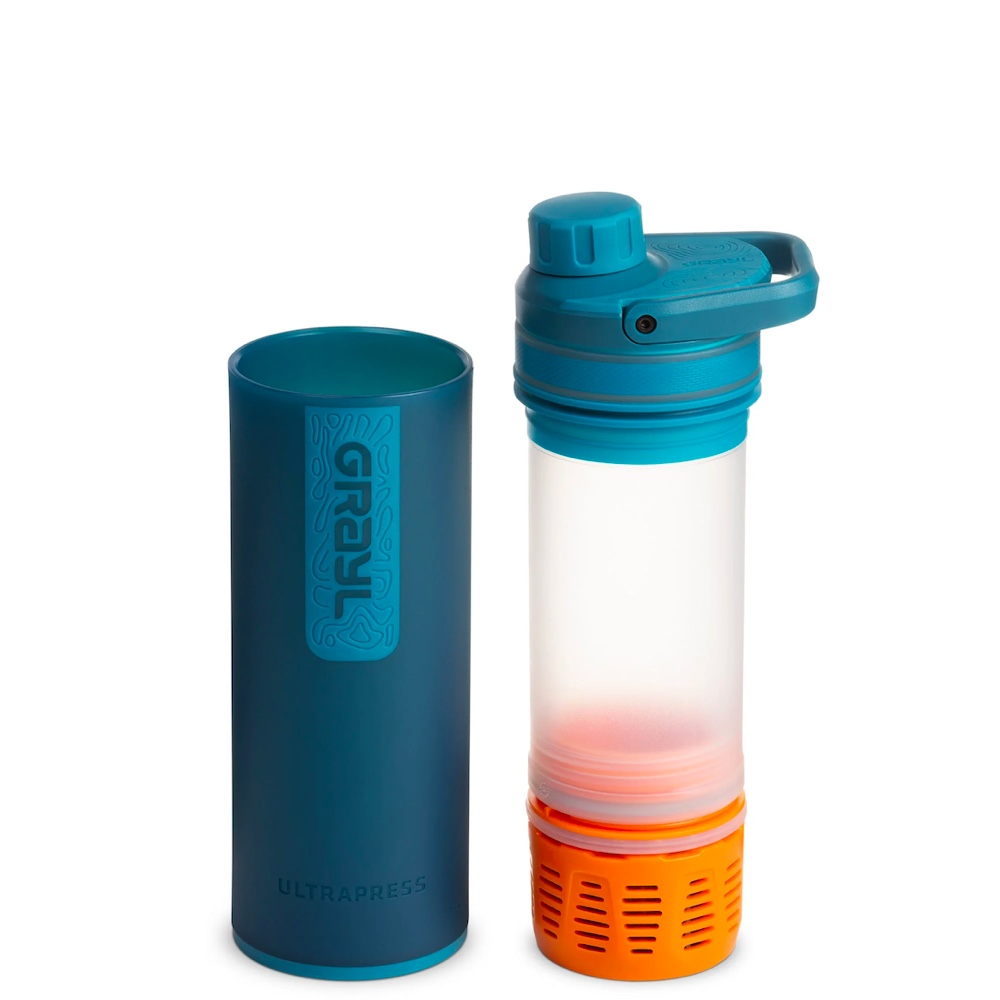
Compact and easy to carry, it quickly eradicates pretty much every undesirable you can think of from your source water, but the press action requires considerable force
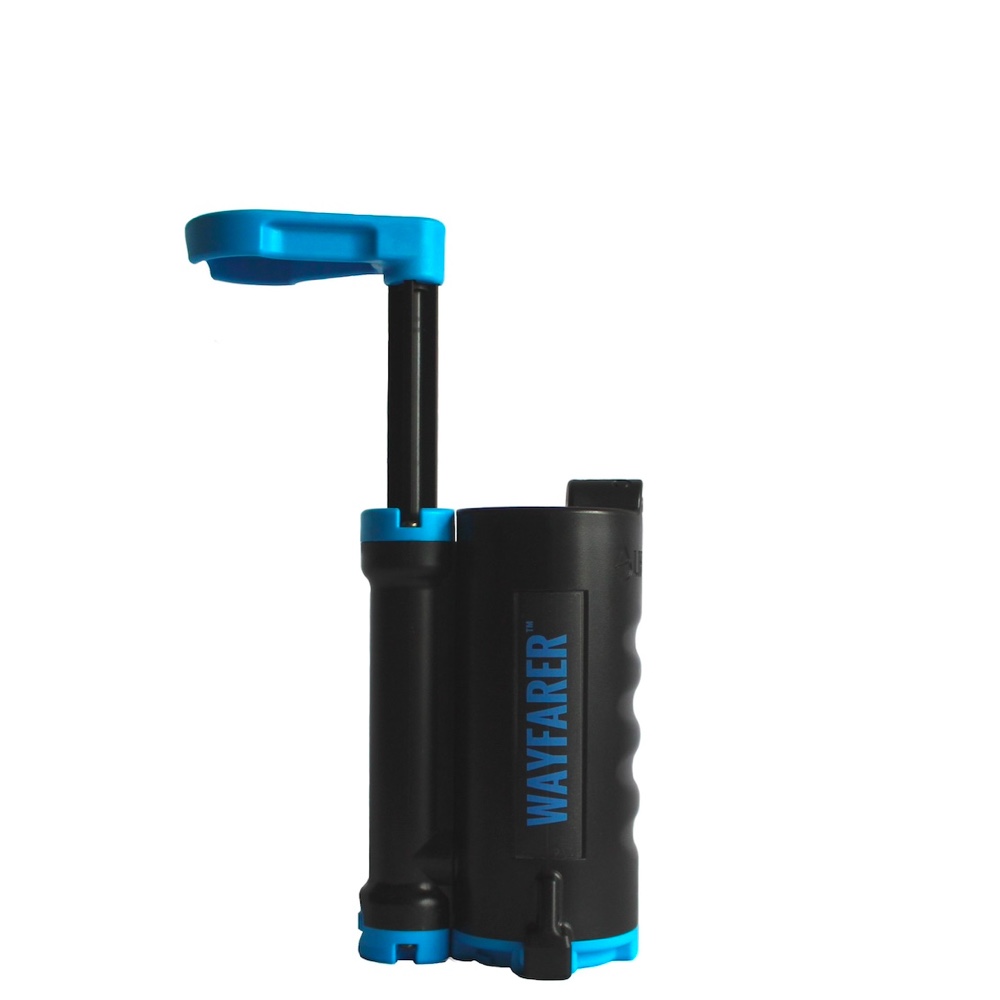
An extremely long-lasting pump-action purifier. The Wayfarer will process 1,320 gallons / 5,000 liters of water (the most of any system on test) before you need to change the filter
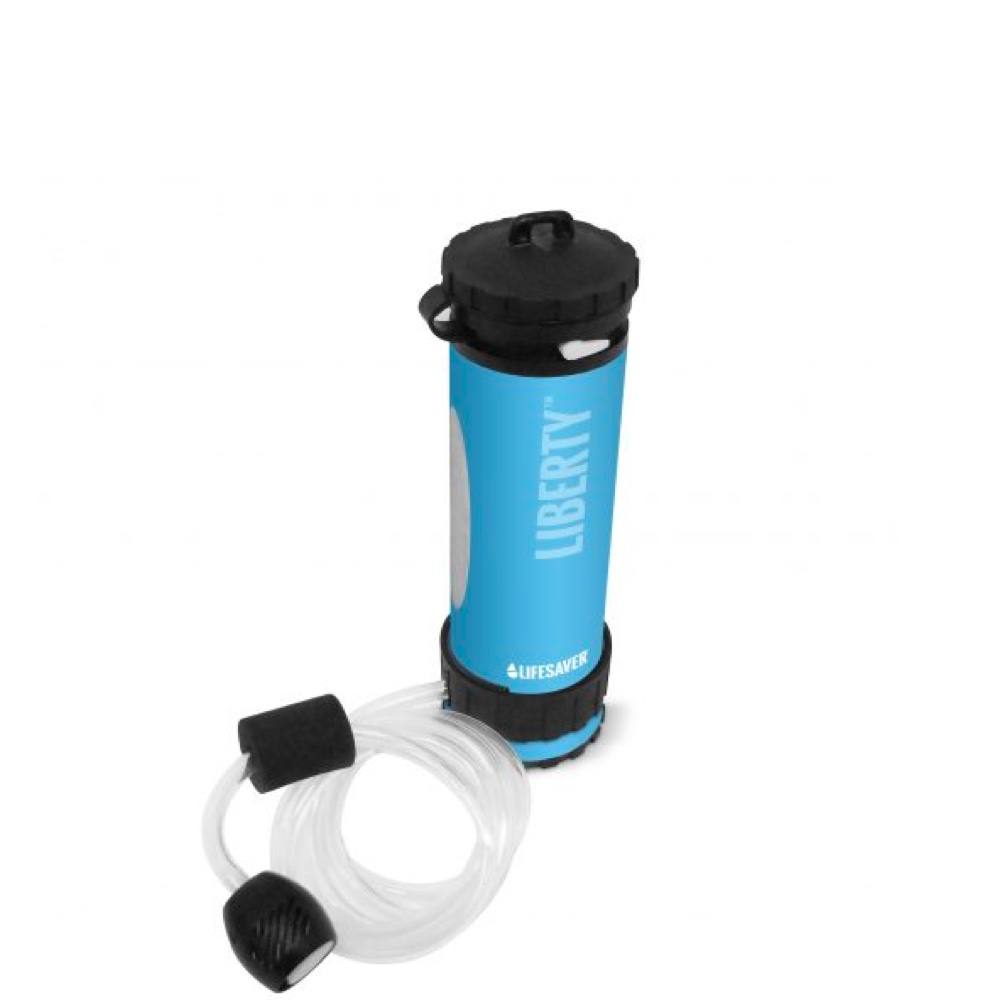
The Liberty from LifeSaver is a compact and comprehensive purifying system for campers that’s capable of dealing with viruses as well as waterborne bacteria, particles and protozoa
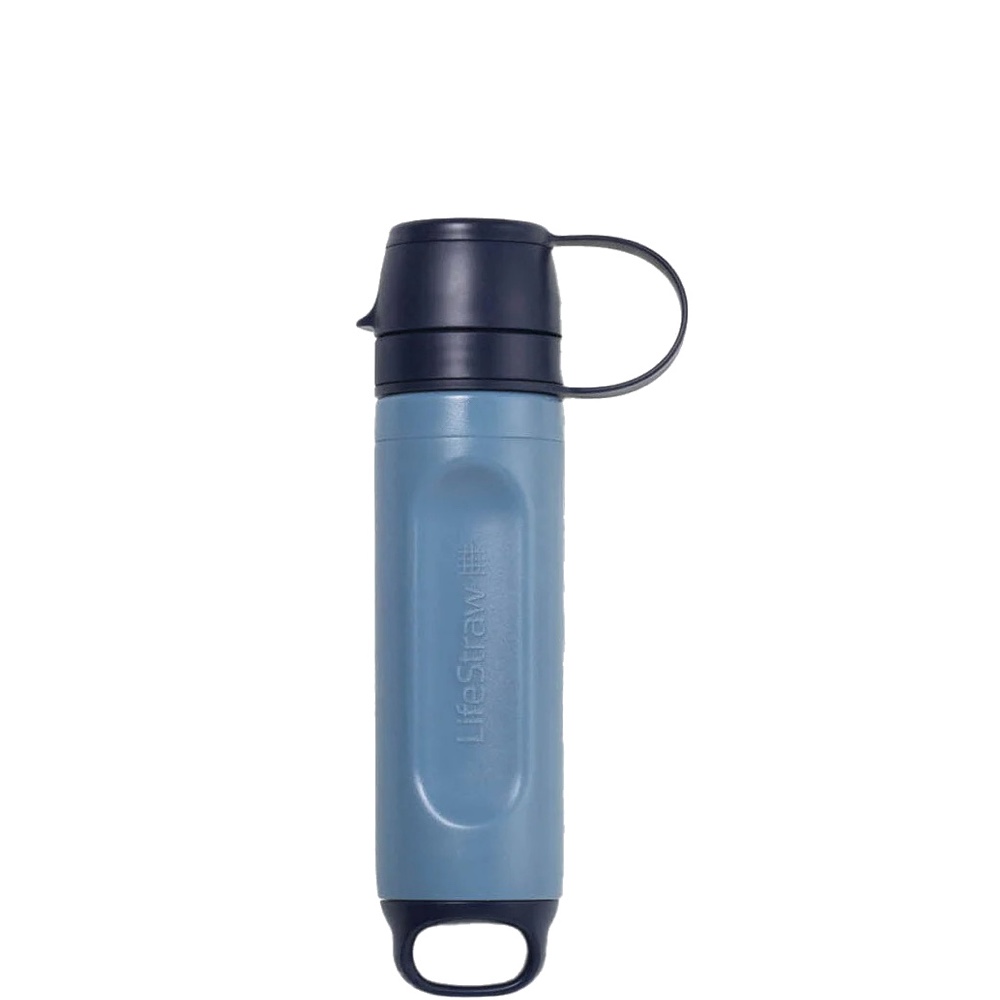
An ultralight and super-small water filtering system that’s perfect for weight-conscious backpackers, bikepackers and fastpackers – easy and quick to use, too
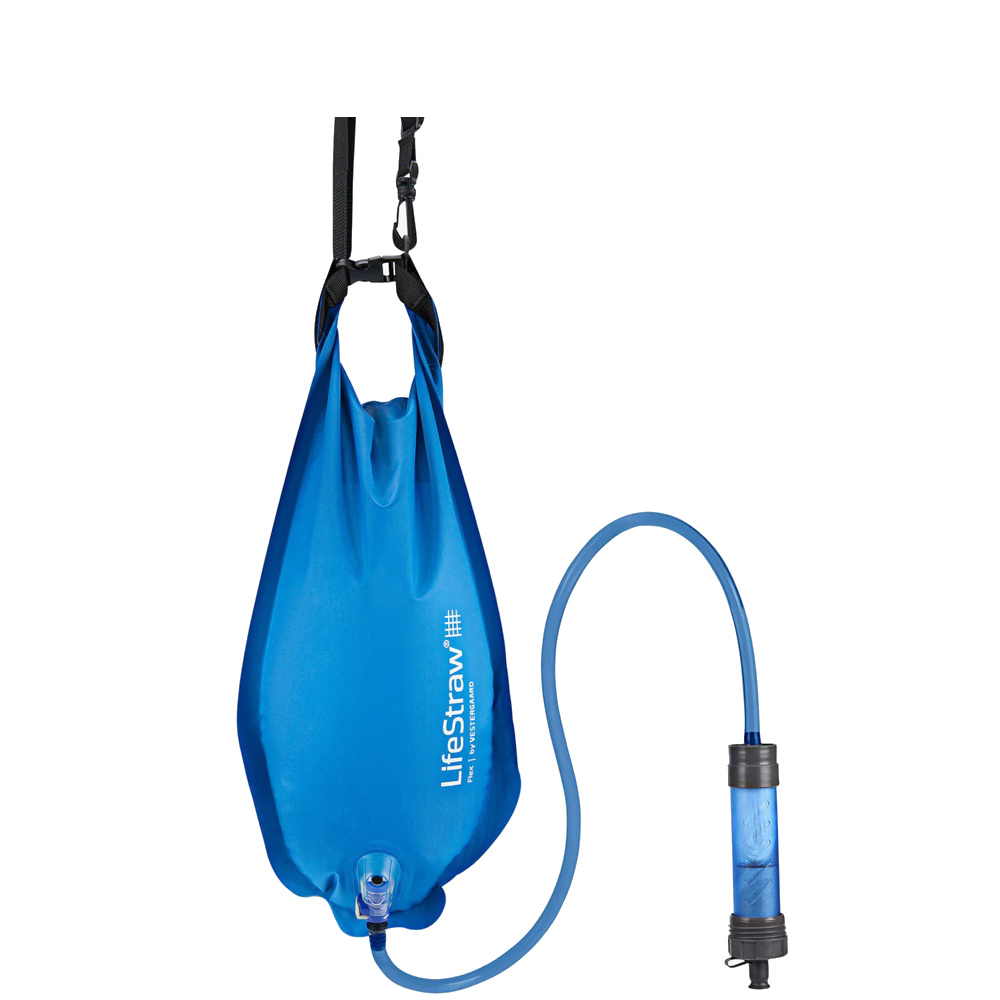
This water filter with gravity bag provides plentiful filtered drinking water for small groups and families of campers. Removes bacteria, parasites, microplastics and heavy metals, and improves the water’s taste
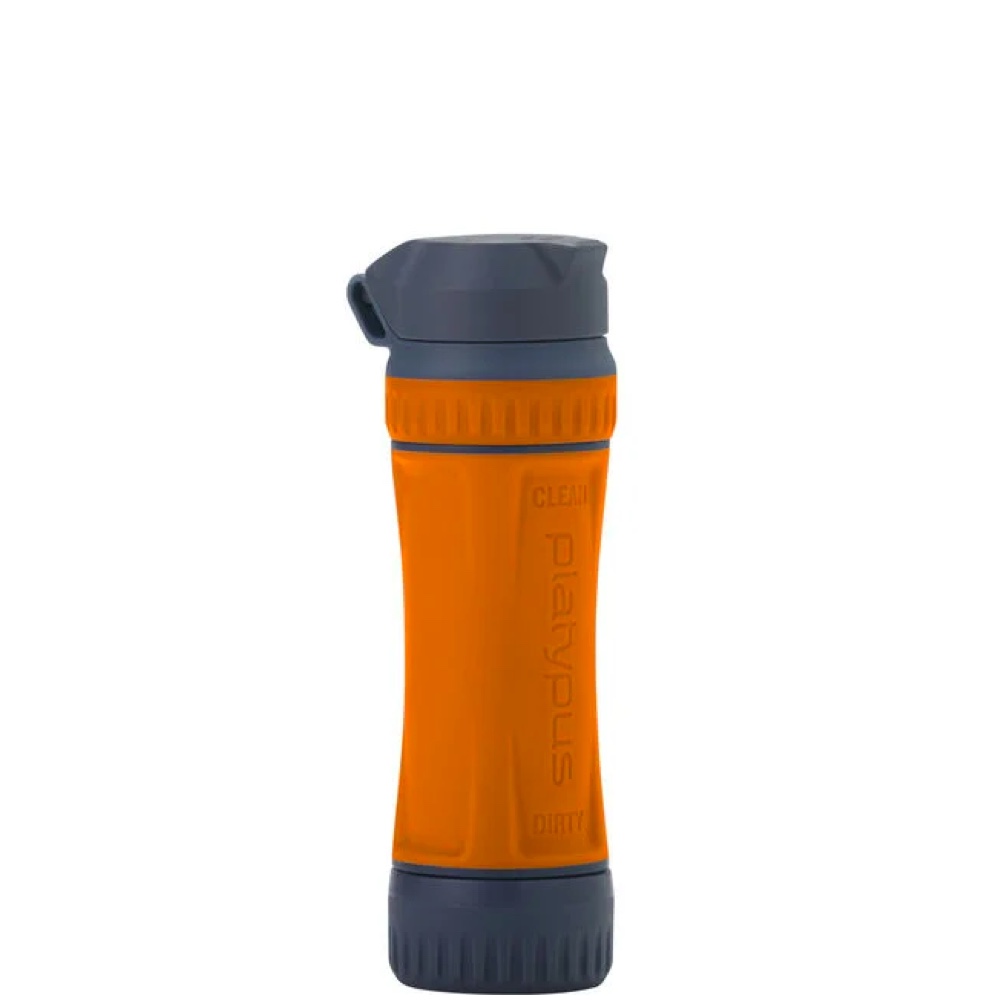
If keeping weight down is an issue, this simple, easy-to-use filter is ideal, but you have to wait longer for clean water than with some of the others. And it doesn’t eliminate viruses
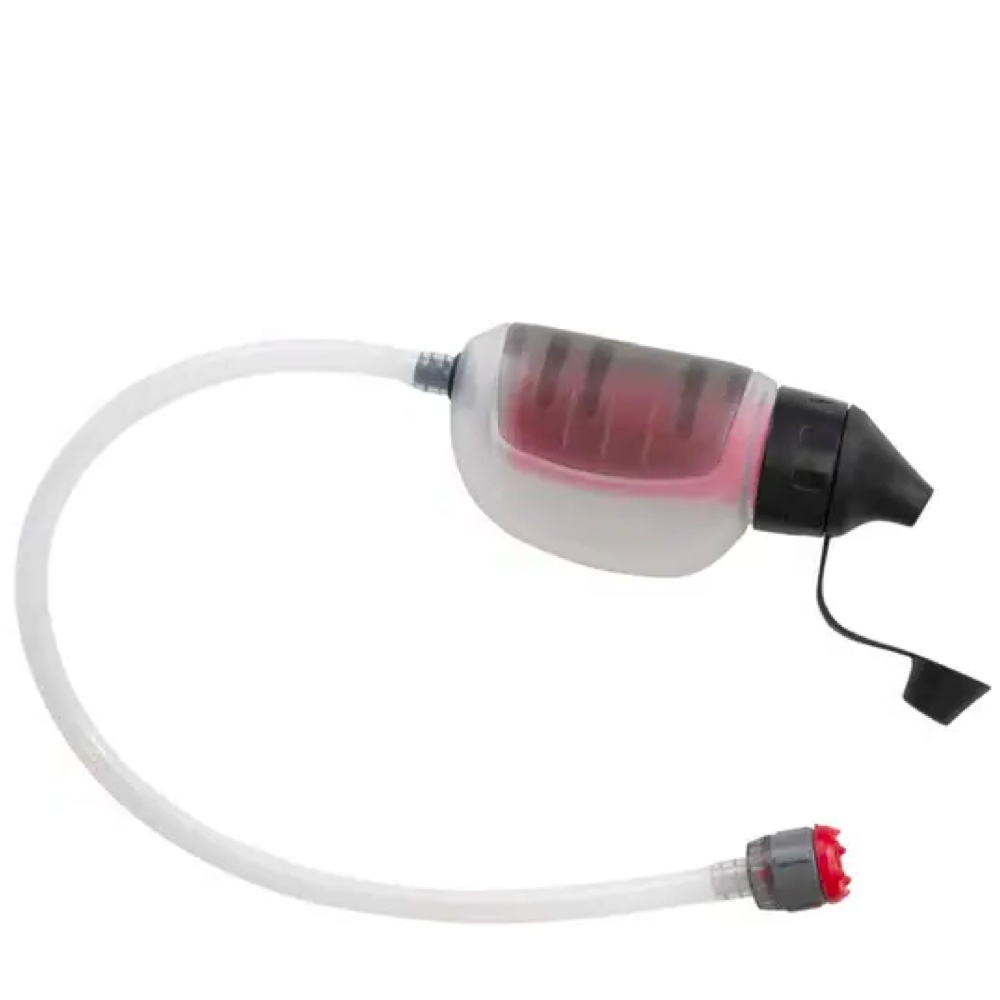
Lightweight, compact and easy to carry, the Trailshot can be operated with one hand, to fill a bottle or bladder, or you can drink straight from the spout. Not the most efficient pump, though
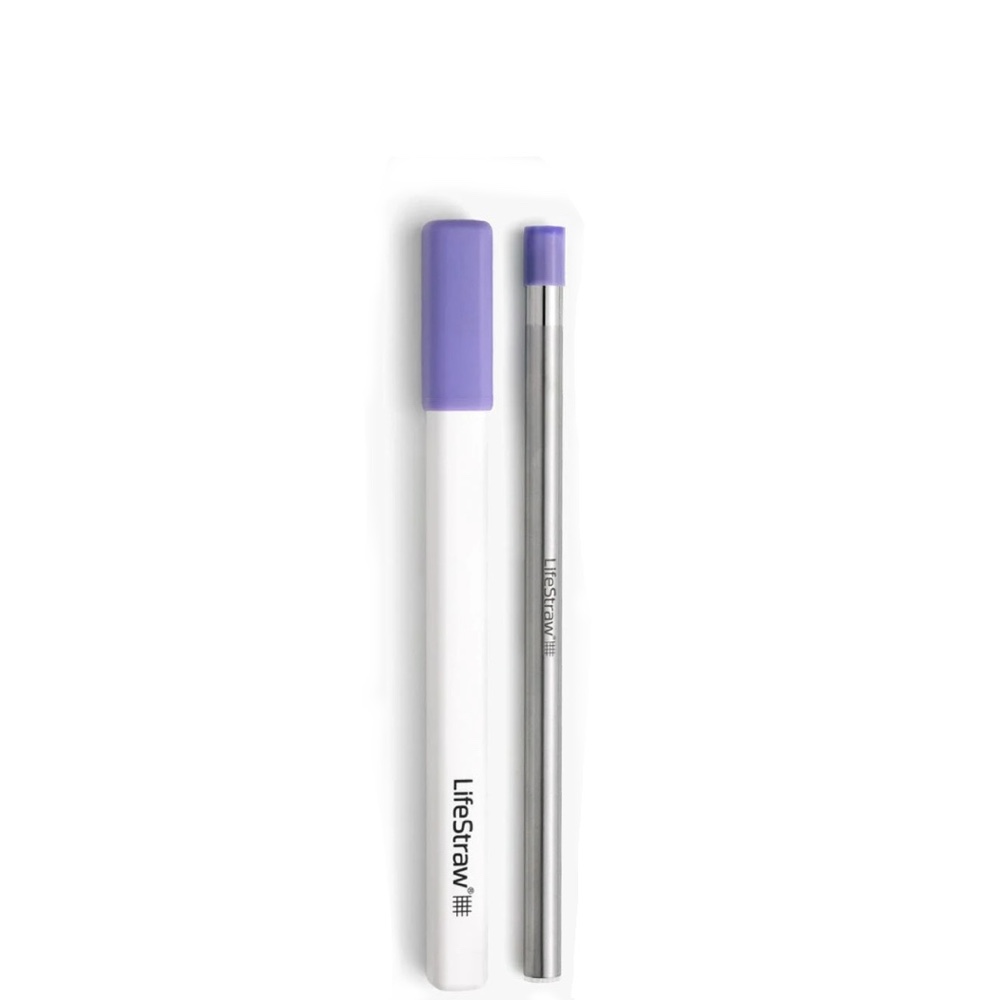
A high-tech straw that’s primarily designed to be used in cafes and bars where you don’t trust the cleanliness. You can also use it to drink straight from streams – it’s certainly long enough
The best water purifiers and water filters 2025
You can trust Advnture
The best press-action water purifier
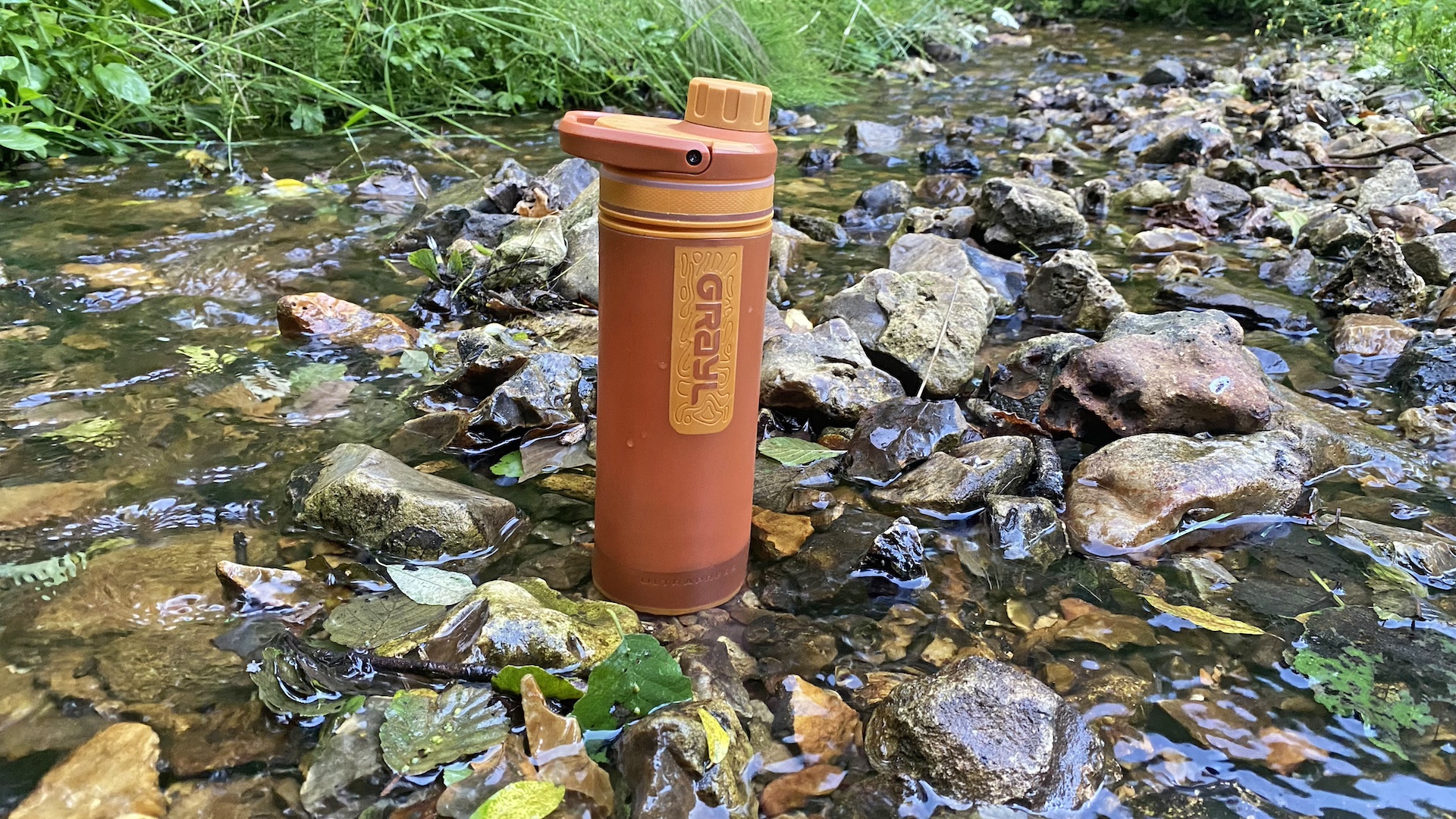
1. Grayl 500ml UltraPress
Our expert review:
Specifications
Reasons to buy
Reasons to avoid
This press-based purification system comprehensively catches a massive range of waterborne nasties, including virus threats that the more lightweight filters can’t deal with.
Extremely simple to use, but requiring a little bit of muscle power (or at least weight), you just fill the outer section of bottle with water from your source, and then – after opening the top valve half a turn to allow air to escape – push the inside section down, forcing the water through the filter. In this way it’s possible to prepare 500ml of drinking water in 10 seconds flat.
Drink straight from the spout, or decant the clean water into another container and press again.
The whole system fits in the bottle pocket of any backpack, and the cup holder of most vehicles.
Grayl have recently added a silicone one-way valve to the UltraPress, which prevents liquids from flowing back into the cartridge, so you can safely add electrolytes and other drink mixes to your purified water in the bottle, without compromising the filter.
It’s a little heavier than other systems, but you can carry the UltraPress empty and fill it as you go, instead of carting water around with you. This super safe system catches viruses, bacteria and protozoa, as well as particulates such as microplastics and sediment, chemicals such as chlorine, and heavy metals including lead. You can perform 300 presses before it’s necessary to replace the purifier cartridge (pressing becomes harder as the filter gets older – when it takes 25 seconds to press, it’s time for a new cartridge).
The best long-lasting purifier
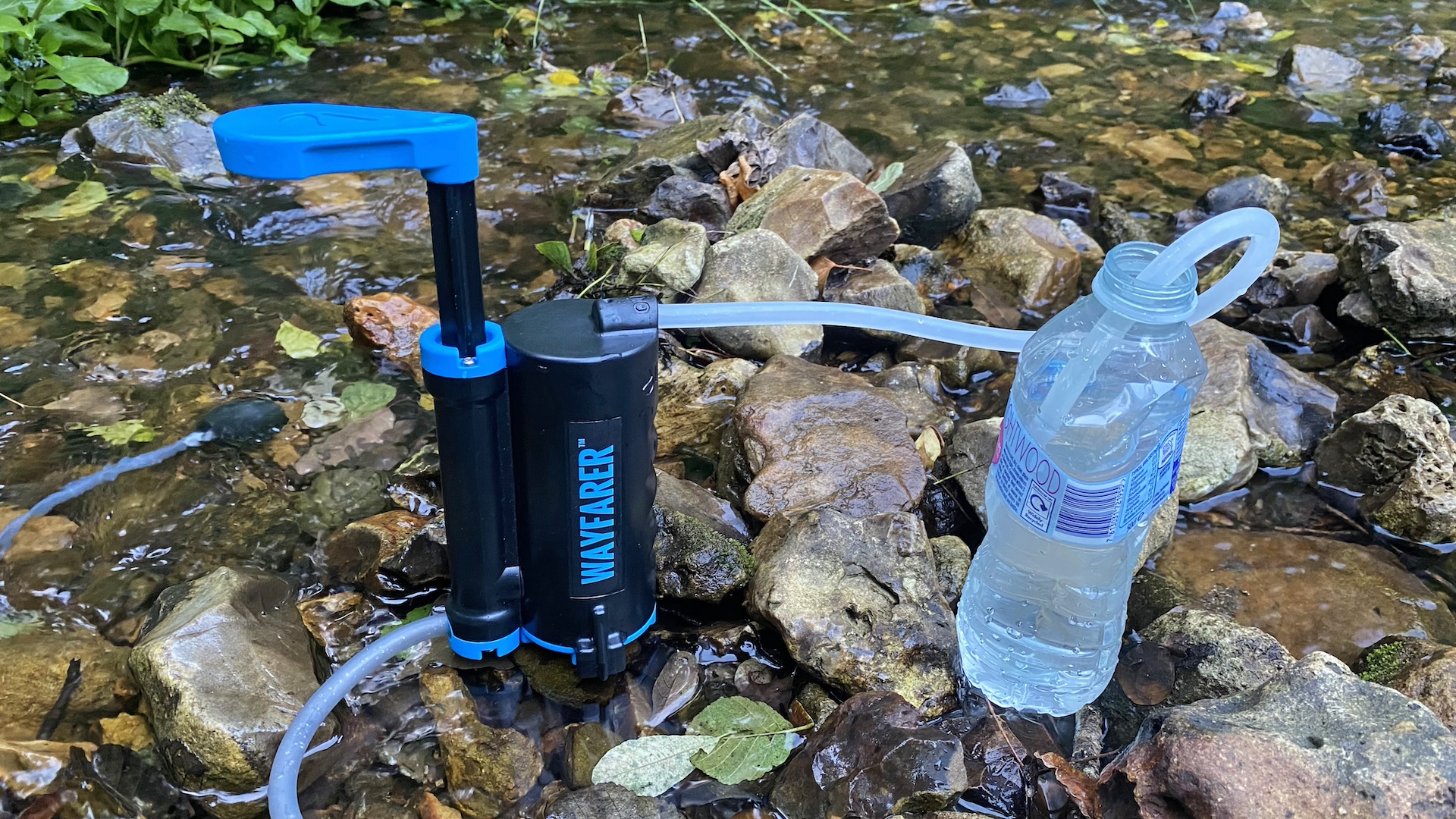
2. LifeSaver Wayfarer
Our expert review:
Specifications
Reasons to buy
Reasons to avoid
This stable, standup, pump-powered purifier features two hoses: a scavenger hose for dipping into the water source (which comes with an adjustable float collar, so you can prevent the input dragging on the silty floor) and an output hose for decanting the clean water into a bottle.
Once you have the hoses in place, flip the blue handle up and start pumping. The water goes through a double filtration process, first passing through an ultrafiltration cartridge that catches bacteria, viruses, cysts, microplastics and other particulate and protozoa larger than 0.015 microns. It then goes through an activated carbon disc, which reduces heavy metals and chemicals, and improves the taste and smell of the water.
The ultrafiltration cartridge on this model is capable of filtering 5,000 liters (the most of any system on test) before requiring replacement (and once the filter has gone beyond its useful life, no water will pass through, providing a failsafe system). The activated carbon disc needs to be renewed after every 100 liters (but the purifier works perfectly well without it).
You do need a stable surface to operate this system, and the pump requires a little bit of elbow grease. Plus, it’s heavier and more bulky than a filter, so you might think twice if you’re planning on carrying it while backpacking (although it is much lighter than carting lots of water, and you can purify from sources as you go). But it’s been thoroughly tested (exceeding NSF/ANSI P231 requirements) and so you can rest assured that it will provide properly purified water when you’re camping for long periods, going on a road trip or travelling in places where potable water is hard to source.
Be careful not to lose the dust cap for the clean outflow, and make sure you purge the water completely after use. On test, we did notice air pockets forming, which made it difficult to put the pump handle back into the storage position and resulted in water occasionally being ejected explosively from the out valve.
The best pump-action purifier
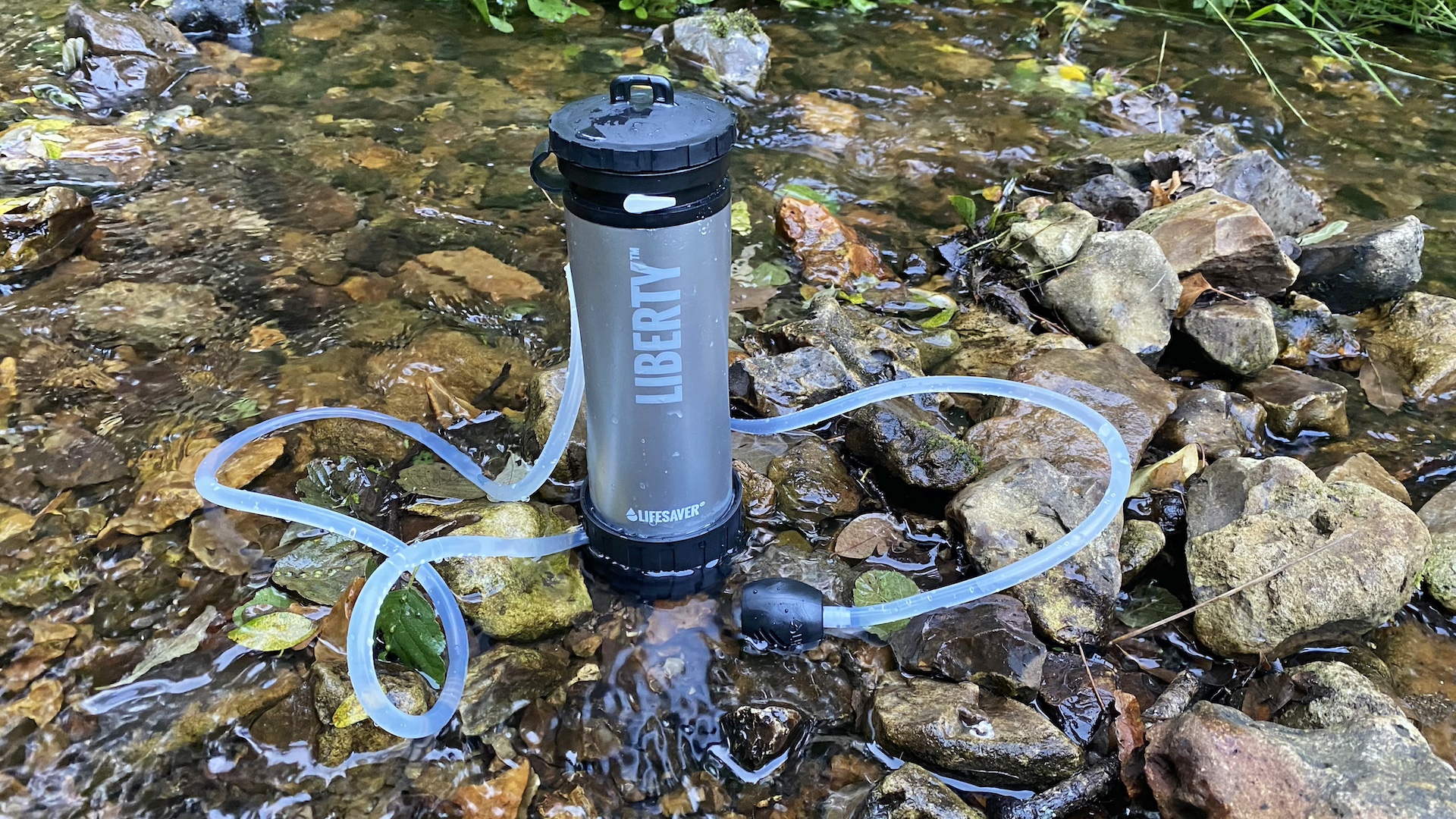
3. LifeSaver Liberty
Our expert review:
Specifications
Reasons to buy
Reasons to avoid
The Liberty from LifeSaver is a compact and comprehensive purifying system for campers that’s capable of dealing with viruses as well as waterborne bacteria, particles and protozoa.
There are two ways of using it: you can either unscrew and remove the bottom section and scoop up a load of water, before reassembling the unit, or you can attach and dangle the supplied scavenger hose into the source (the hose comes complete with a little float, so you can prevent it touching the bottom and getting silt-clogged).
Once the unit is full of water, or the hose is in position, you use the pump on the base to pressurize the inside and force the water through the filter. When you’re ready to drink or decant the purified water into another container, open the top section and flip the white lever into the upright position. Be prepared, because the pressurized water will spurt fountain-like from the top of the unit at first.
The filter is good for around 528 gallons / 2,000 liters (after which time you can replace it), and the failsafe system means it stops working altogether once it’s maxed out, so you can’t accidentally drink non-filtered water.
Besides the microfilter, an activated carbon disc deals with heavy metals and improves the taste and odor of the water (and we can testify that it really does make it taste sweeter, no matter how mucky the source); this disc needs to be replaced after about 26 gallons / 100 liters, but the unit can be used without it.
The system fits into a backpack pocket, and can be carried full, but it only takes 13.5floz / 400ml – it’s best suited for use in camp when you’re set up for a few days, or during canoe trips (a loop on the lid enables you to secure it).
The best compact water filter
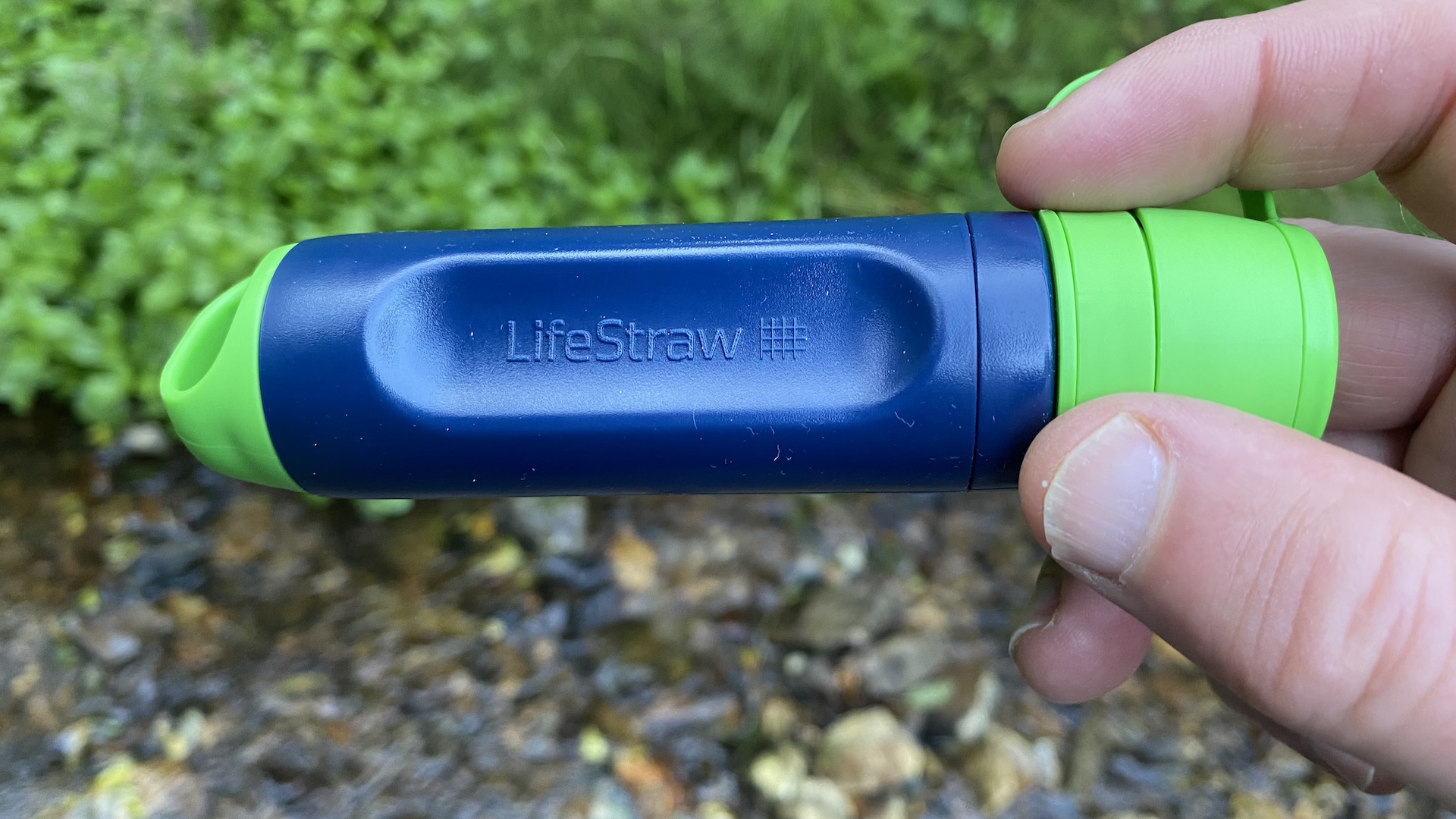
4. LifeStraw Peak Solo
Our expert review:
Specifications
Reasons to buy
Reasons to avoid
An ultralight and super-small water filtering system that’s perfect for weight-conscious backpackers, bikepackers and fastpackers, the LifeStraw Peak Series Solo unit is even more compact than LifeStraw’s Personal Water Filter Straw – it literally fits into the pocket of any daypack, backpack, bike bag, coat or hiking pants.
It’s ridiculously easy and quick to use – you simply pop the top cap off, unscrew the bottom cover, dip the end in the water source and suck. Alternatively, you can fill a standard disposable bottle full of water, screw the unit onto the top, invert it and either drink the filtered water straight from the Solo unit, or decant it into another container. It’s possible to fill a 0.25 gallon / 1L bottle with filtered water in 20 seconds.
The big drawback to this system – as with all water filters – is that while it does an excellent job of removing bacteria and particulates, it doesn’t catch waterborne viruses. You also need to be careful not to lose the bottom cover, which unlike the top cap, isn’t attached to the unit.
The filter should last for about 528 gallons / 2,000L (the unit stops allowing water through once it’s no longer effective), but while the Solo is available for a very accessible price compared to some systems – especially purifiers – when the filter is maxed out you need to replace the whole unit.
As the name suggests, the Solo doesn’t come with a bottle, but these are all too easy to source because the thread connects to most screwtop bottlenecks. Alternatively, for a slightly larger outlay you can purchase the LifeStraw Peak Series Squeeze Bottle with Filter, which is exactly the same system built into the top of a soft bottle. Both versions come with a backwashing syringe for cleaning the filter out.
It’s worth noting that, with each purchase, LifeStraw provides clean water for a child in need in the developing world.
The best water filter for small groups
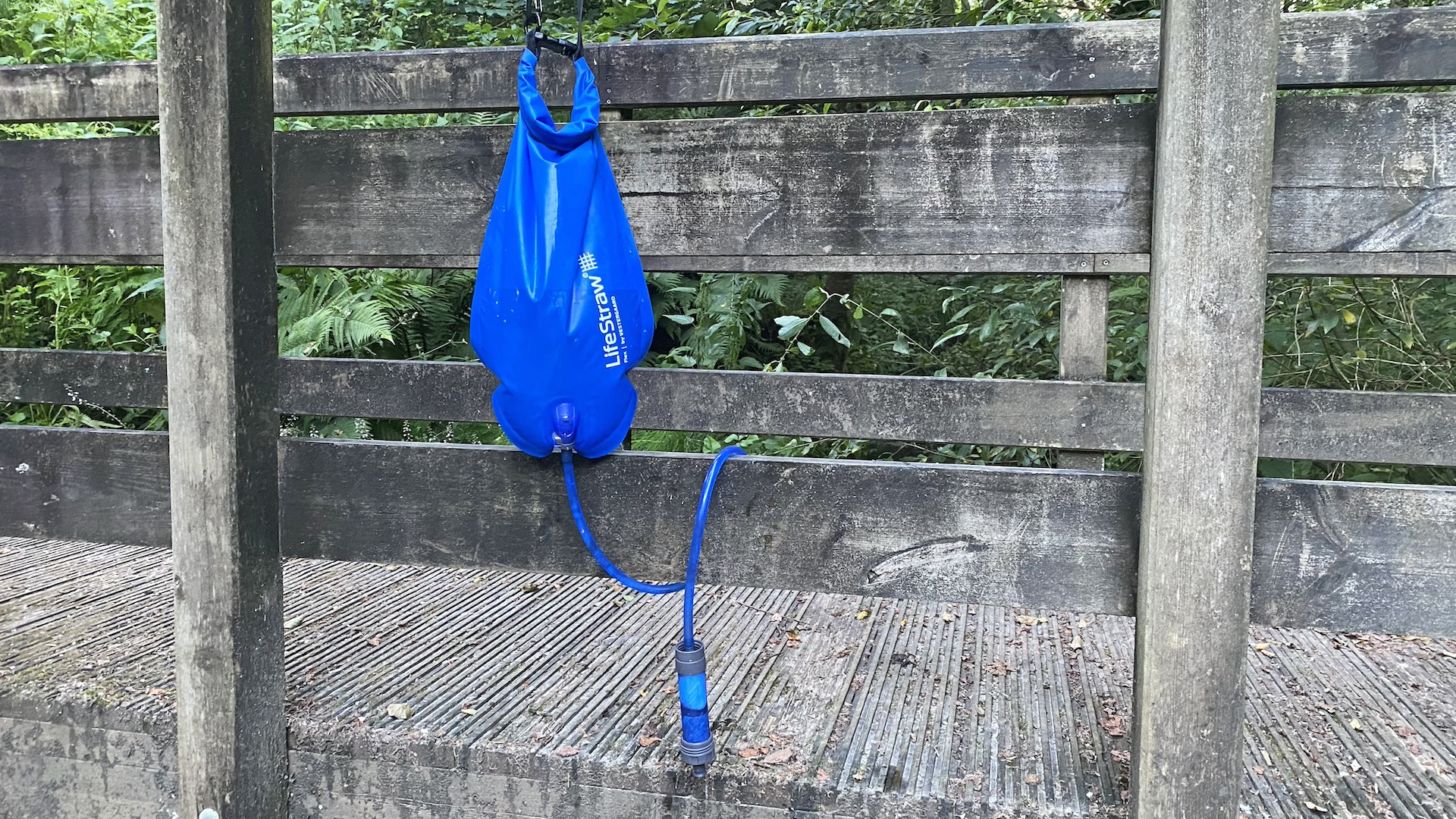
5. LifeStraw Flex
Our expert review:
Specifications
Reasons to buy
Reasons to avoid
Easy to assemble and use, the LifeStraw Flex with gravity bag system can provide plentiful filtered drinking water for small groups of campers, such as families. Simply fill the 1gal (3.7L) bag from the water source and then hang it from a tree or other structure in camp, using the strap and clip (included).
Gravity feeds the water through a hose to the LifeStraw Flex filter unit, from which you can fill cups, glasses, water bottles or hydration bladders – or just put your mouth underneath it and drink.
As well as a hollow-fiber membrane microfilter, which removes bacteria, parasites and microplastics, this system also has an activated carbon fiber capsule that reduces chlorine and heavy metals (including lead) and improves the taste of the water.
The hollow-fiber membrane is effective for 2,000L (500 gallons), and stops letting water through once it’s ceased working, at which point you can replace it. The carbon fiber capsule needs to be replaced after you’ve filtered around 100L (25 gallons) of water. Aside from working with the hang-bag, the Flex Filter unit can be used with a plastic water bottle (a threaded valve attaches it to a standard soft bottle in place of the lid); a hydration pack (this requires cutting the hydration pack’s hose and attaching the filter unit the right way around); or even as a stand-alone straw.
The kit comes with a backwashing syringe that should be used regularly to flush water through the filter, which will extend the product’s life.
The best squeeze filter
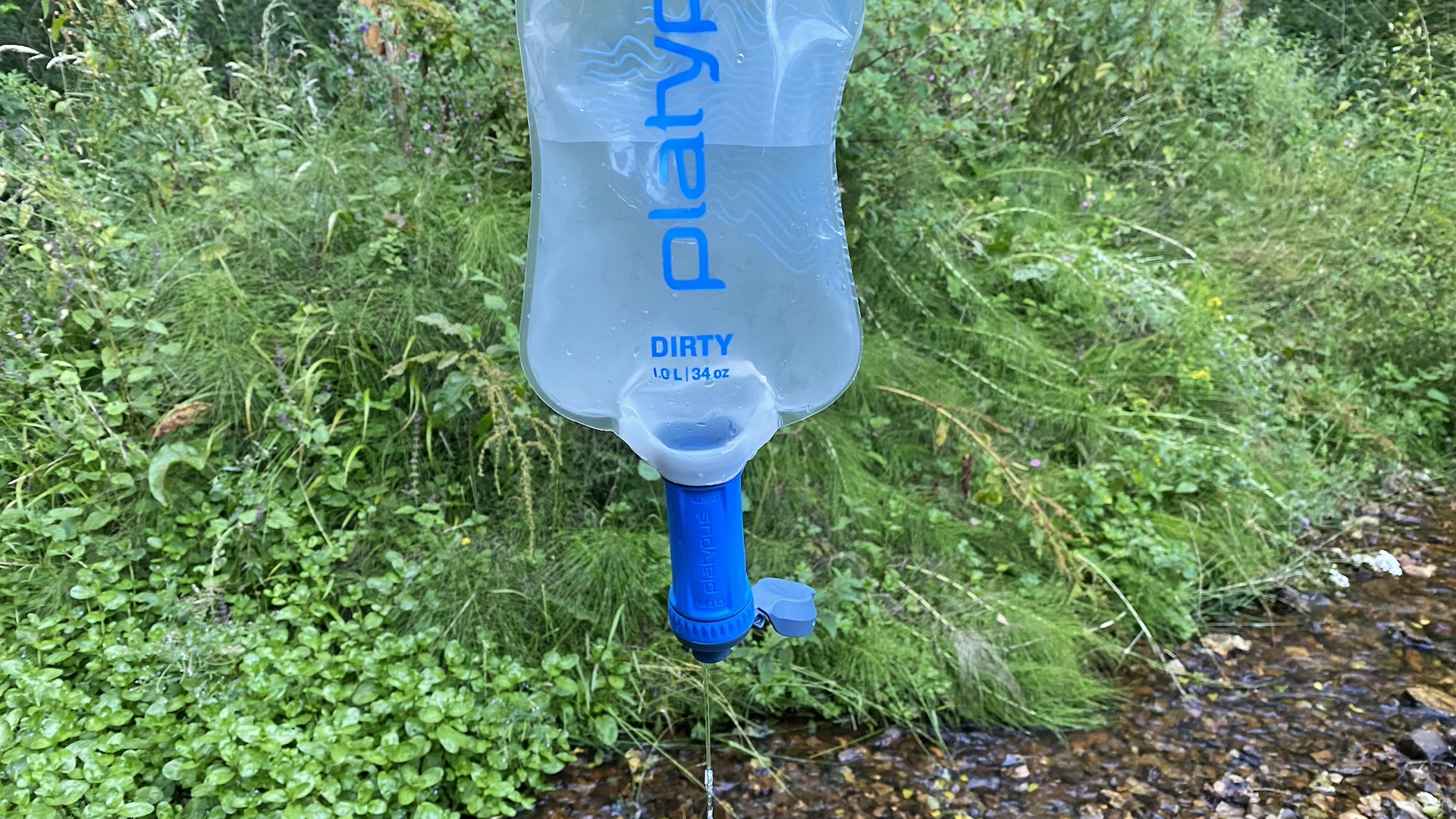
6. Platypus QuickDraw
Our expert review:
Specifications
Reasons to buy
Reasons to avoid
This simple water filtering system is light and highly packable, as well as being extremely easy to use – making it ideal for trekking, backpacking and other trips where weight is a big factor.
Simply fill the supplied 1L Platy bottle (clearly marked ‘dirty’ to avoid confusion) from the water source, attach the QuickDraw unit (also marked, with a ‘dirty’ and a ’clean’ end) and then squeeze the water through.
With the cap of the unit flipped open, you can drink straight from the ‘clean’ end of the straw (which has a spout), or decant the filtered water into another bottle.
While it isn’t effective against viruses, the QuickDraw will catch pretty much all waterborne bacteria and protozoa. The collection reservoir is double layered, to make it durable and taste-free, but you can use other water bottles if you so desire.
To clean the system, just backwash it by shaking it. While you can keep using the bottle forever, the filter unit has to be replaced after processing about 264 liters / 1,000 liters.
The best portable pump-action filter
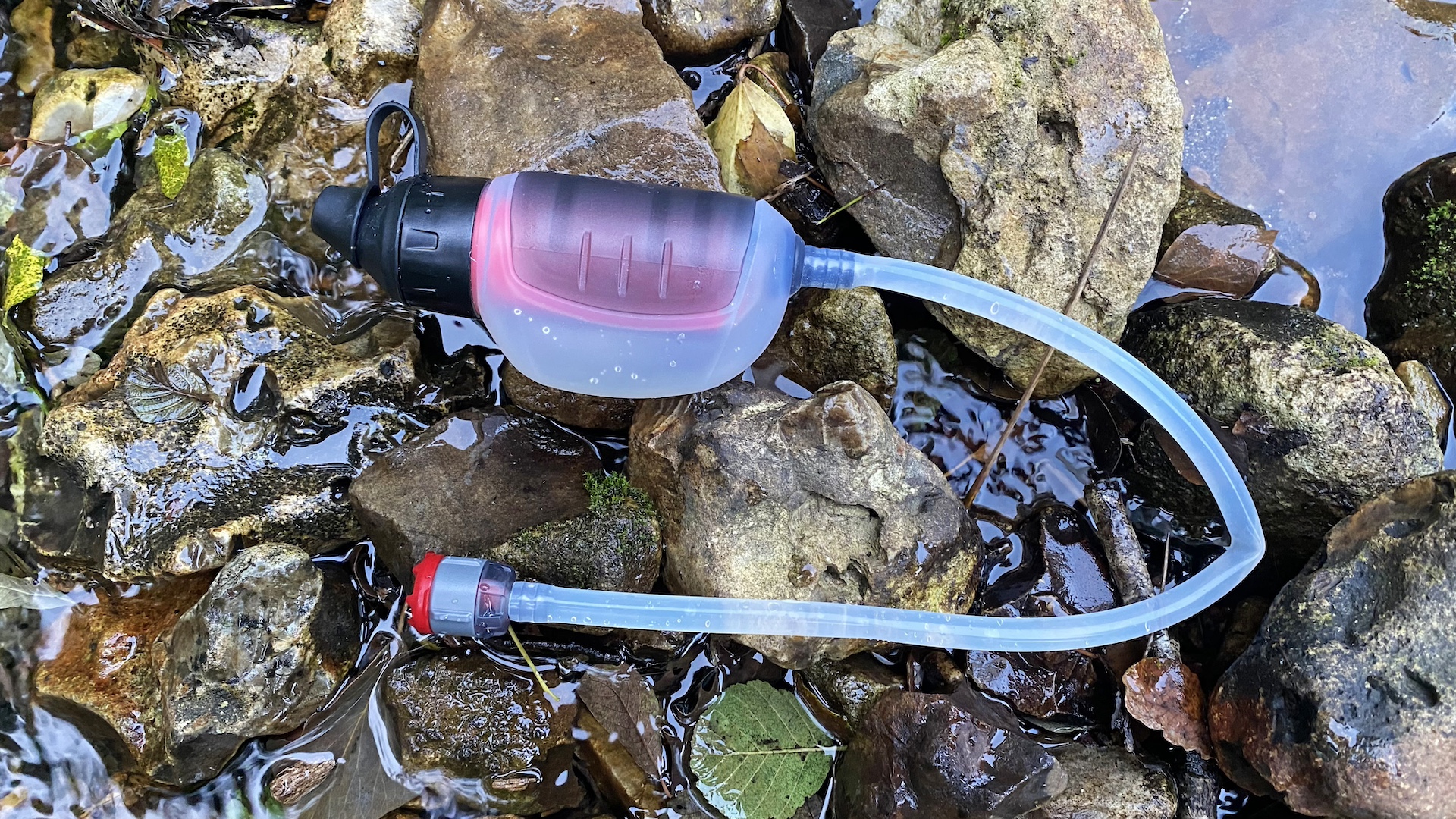
7. MSR Trailshot
Our expert review:
Specifications
Reasons to buy
Reasons to avoid
Lightweight, compact and easy to carry in a backpack, hydration pack or even the pocket of a jacket or hiking pants, the Trailshot is from excellent outdoor brand MSR (Mountain Safety Research). It can be operated with one hand, to fill a water bottle or bladder, or even filter water directly into your mouth.
It’s a pump system, so you place the hose into the water source and squeeze a bulb section several times to draw the liquid through the filter, before decanting it into your vessel of choice, or sipping it directly from the spout. Capable of filtering a liter of water in 60 seconds, this system removes the vast majority of bacteria (such as E.coli and Salmonella) and protozoa (such as Giardia and Cryptosporidium), but like all filters, it isn’t effective against viral pathogens such as norovirus.
The Trailshot will process about 528 gallons / 2,000 liters of water before the filter needs to be changed (it becomes clear when you’re approaching this point when the rate drops below 8.5 oz / 250ml per minute). On test, the hand-squeeze pump – while nice and light – wasn’t as efficient at drawing water through the system as some other pumps featured here.
The best filter for travelling
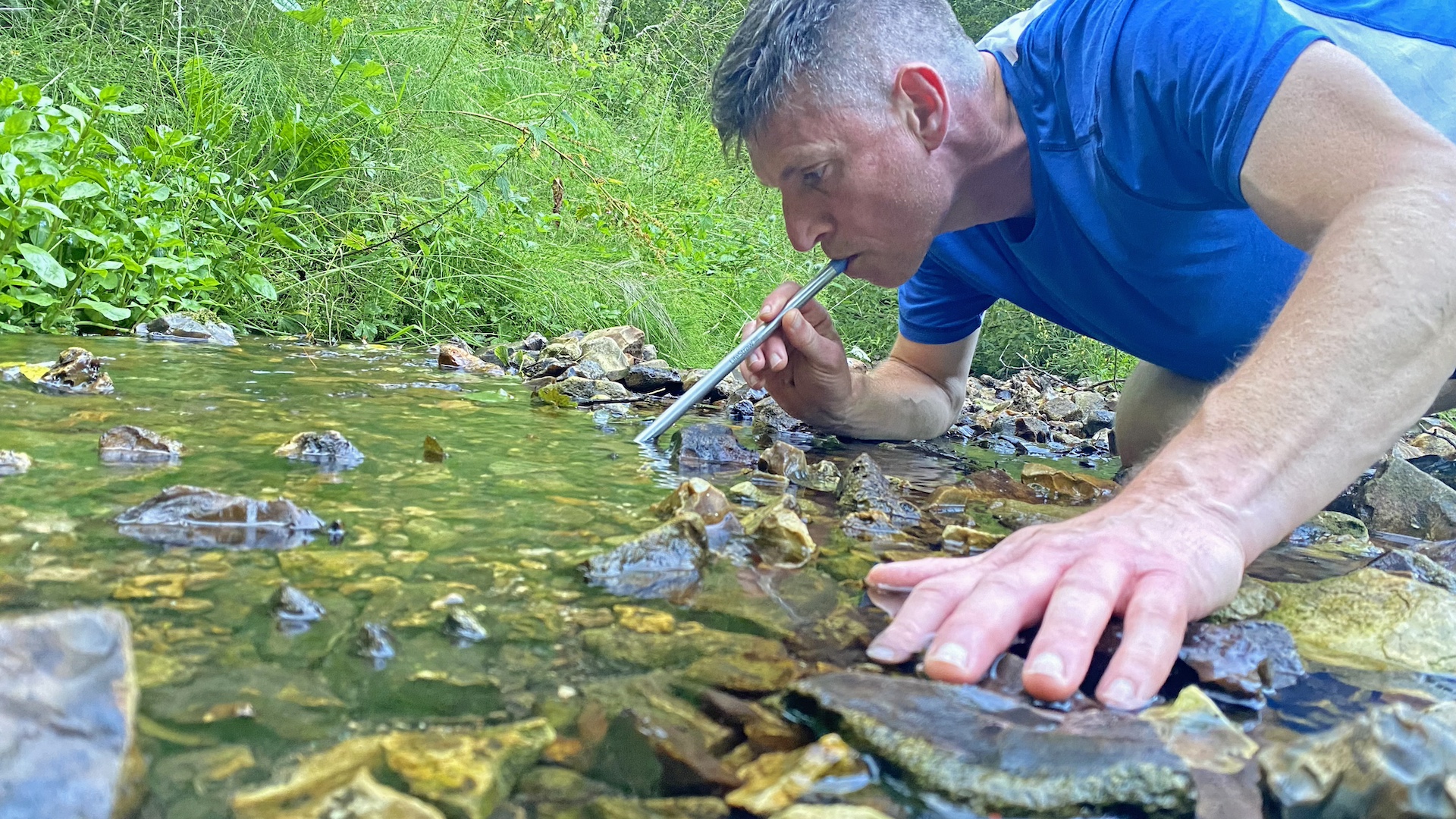
8. LifeStraw Sip
Our expert review:
Specifications
Reasons to buy
Reasons to avoid
The latest water filtering offering from LifeStraw is a skinny straw primarily designed for use by travelers concerned about picking up bugs from water and ice supplied in drinks, and is styled to be discreet when used in cafes, bars and restaurants in holiday destinations.
However, it essentially contains the same tech as featured in the Peak Series Straw, and can be used as a lightweight and easy-to-carry device to filter stream water while you’re on the trails, at home or abroad. Longer than the Solo, it can be used to reach stream water from the bank without getting your feet wet, but there’s no option to attach a bottle, so the only way to use it is by sucking water as you go (you can’t decant filtered water into another container).
As with all filters, it will catch the vast majority of bacteria and particulates, but not waterborne viruses, chemicals or heavy metals – to remove these you need a purifier. The membrane-based microfilter can process about 264 gallons / 1,000 liters over its life span, and it stops letting water through when it’s no longer effective, so you can’t accidentally drink unfiltered water. Once it’s spent, the entire unit needs to be replaced.
The Sip comes in a variety of colors, and with a matching carry case that keeps the straw nice and clean.
The best water purifiers and filters comparison table
Filter / Purifier | Type | Rate | Weight |
Grayl 500ml UltraPress purifier | Press action | 3L per min | 354g / 12.5oz |
LifeSaver Wayfarer purifier | Pump-powered two-stage purifier | 1.4L per min | 323g / 11.4oz |
LifeSaver Liberty purifier | Pump-action purifier with scavenger hose | 1.2L per min | 425g / 15oz |
LifeStraw Peak Solo filter | Sucking action | 3L per min | 48g / 1.7oz |
LifeStraw Flex filter | Gravity-fed large bag | 500ml per min | 196g / 6.9oz |
Platypus QuickDraw filter | Squeeze filter and straw | 3L per min | 100g / 3.3oz |
MSR Trailshot filter | Hand pump | 1L per min | 142g / 5oz |
LifeStraw Sip filter | Sucking action | n/a | 89g / 3.1oz |
Meet the expert
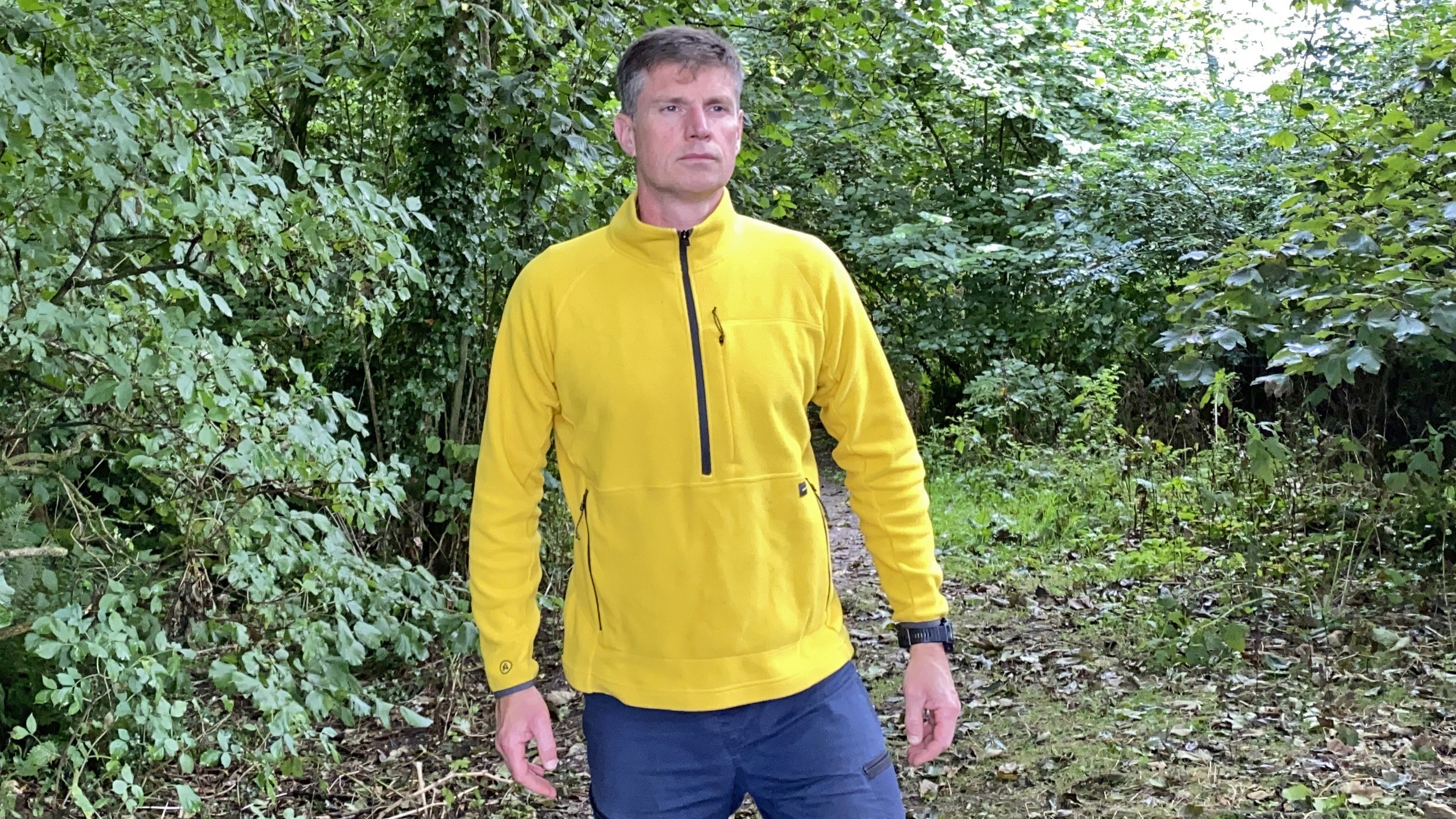
Pat has hiked all over the world, his adventures taking him to Mont Blanc, the roof of Western Europe; the Norwegian Alps; the highest peaks in Australia; and New Zealand’s Great Walks, among others. He’s an experienced tester of all kinds of outdoor gear, and isn't afraid to slosh around in cloudy waterways putting filters and purifiers on trial.
How we test the best water purifiers and filters
Our reviewer took all these water purifiers and filters out in the field on various types of adventures – from short hikes to multi-day treks, alone and in groups – to test their strengths and weaknesses. And yes, he really did use that straw in a stream.
How to choose the best water filters and purifiers
There are lots of water filters and purifiers on the market for backcountry hikers, bikers, backpackers, campers, climbers, paddlers and travellers, and it’s important to get the right system for your requirements. Preventing illness and keeping yourself hydrated are extremely important considerations, so you need to know what the system you are considering getting can (and can’t) protect you from.
Filter or purifier?
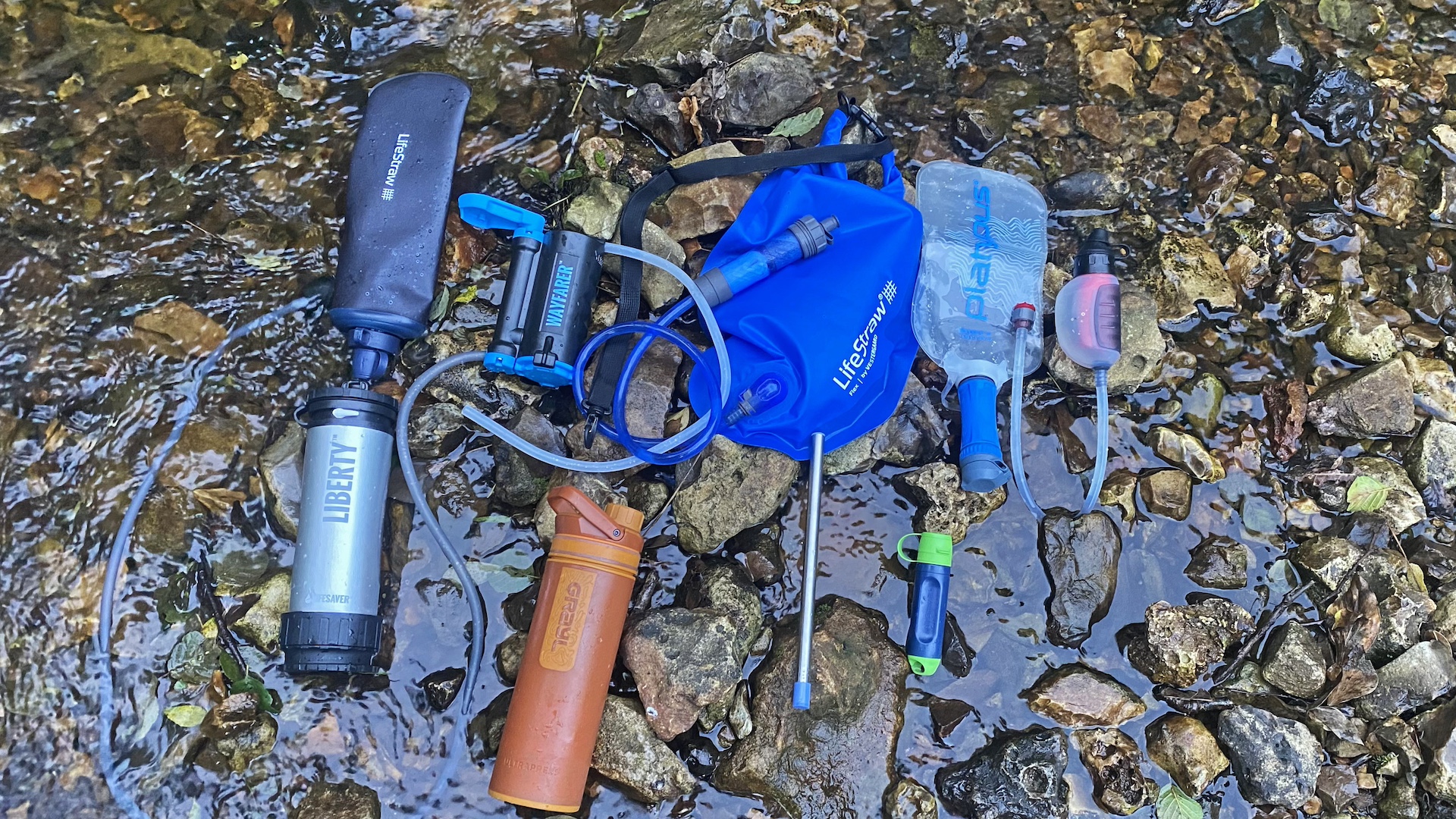
There is a crucial difference between water filters and water purifiers: filters will catch and remove the vast majority of waterborne bacteria (such as E.coli, salmonella and other dysentery-causing nasties) plus particulates (microplastics, sediment, silt) and protozoa (such as giardia, cryptosporidium, cysts, amoebae). However, they will not catch waterborne viruses, including rotavirus, norovirus and hepatitis A.
To get the bacteria, particulates, protozoa and the viruses, you need a water purifier, which is more comprehensive system with a smaller microbiological pore size (0.015 microns). Many of these purifiers (such as the Grayl UltraPress and the LifeSaver Wayfarer) will also remove chemicals and heavy metals (eg. lead) and the ones with an activated carbon disc even make the water smell and taste sweeter.
The downside is that purifying systems are heavier, bulkier and more expensive than filter systems. Do you really need a system that removes waterborne viruses? If you’re drinking from mountain streams, fairly close to the source, then possibly not, but it’s worth noting that people have been suffering symptoms of norovirus after swimming in UK waterways recently.
What about weight?
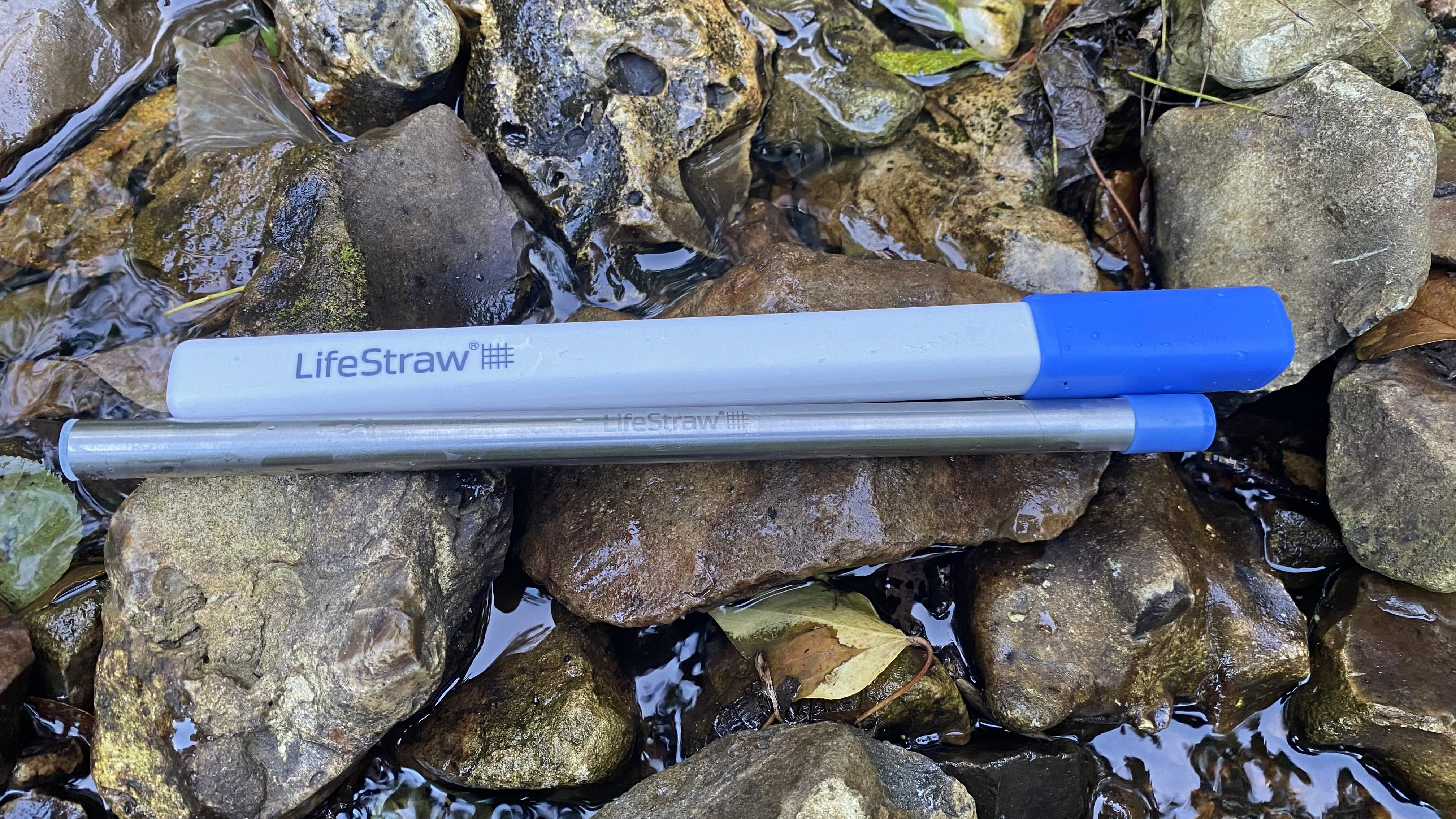
While some of these systems, especially the more comprehensive purifiers, can seem a bit heavy to take on backpacking escapades, they’re all significantly lighter than carting liters of water around on the trails, whether you use a bottle or backpack hydration system.
For reference, 17 fl oz / 500ml of water weighs 17.6oz / 500g, which is considerably more than even the heaviest purifying system included here. If you know you’re going to be crossing and camping near reliable water sources, it’s more weight-effective to carry a purifier.
Be careful – just because a stream is marked on a map, that doesn’t mean it will be flowing when you reach it. A purifier that allows you to transport some water along the trail is the best belt-and-braces approach.
Longevity
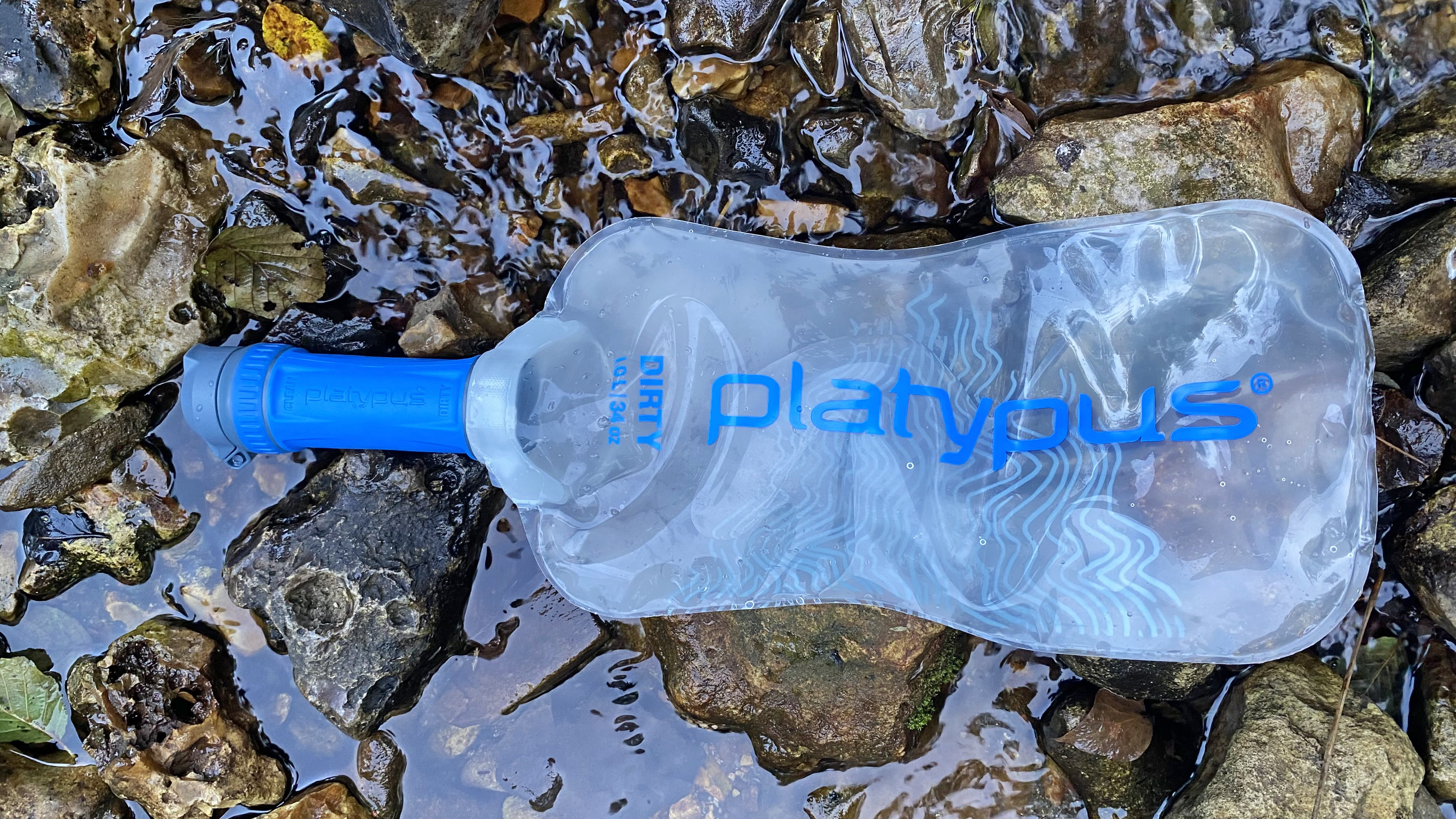
The filters and purifiers featured here are capable of cleaning between 264 and 1,320 gallons / 1,000 and 5,000 liters of water before parts need replacing, which means even the ones at the lower end of that scale could be used daily for a whole year (assuming you drink about three liters per day) before the filter becomes maxed out – not bad compared to the price of buying bottled water in equivalent quantities, and with a fraction of the environmental cost.
Top tips for using your filter or purifier
Like any piece of kit, a water filter or purifier will work better and for longer if you take care of it.
Prime your purifier and purge your filter
Some products (typically the purifiers) stress the importance of this more than others, but it’s always worth priming your water filter or purifier before you start using it for real. It’s a simple process that just involves operating the device with clean water, putting a few liters through the system. This gets the filter working better, and it’s a good idea to figure out how to use the kit and iron out any doubts or problems before you hit the trail.
Once you have used the filter or purifier properly with ‘dirty water’, it’s a good idea to purge the system afterwards with clean water.
Use the best, clearest water possible
When you’re collecting water from the source, try and get the clearest water you can. Running water is always better than still (potentially stagnant) water, and avoiding silt and dirt where possible will mean the filter works for longer. Devices with a scavenger hose should come equipped with a floating collar that you can put around the hose to avoid the collection bulb at the end dragging in the muck and silt at the bottom of a stream or river.
All the latest inspiration, tips and guides to help you plan your next Advnture!

Author of Caving, Canyoning, Coasteering…, a recently released book about all kinds of outdoor adventures around Britain, Pat has spent 20 years pursuing stories involving boots, bikes, boats, beers and bruises. En route he’s canoed Canada’s Yukon River, climbed Mont Blanc and Kilimanjaro, skied and mountain biked through the Norwegian Alps, run an ultra across the roof of Mauritius, and set short-lived records for trail-running Australia’s highest peaks and New Zealand’s Great Walks. He’s authored walking guides to Devon and Dorset, and once wrote a whole book about Toilets for Lonely Planet. Follow Pat’s escapades on Strava here and Instagram here.
